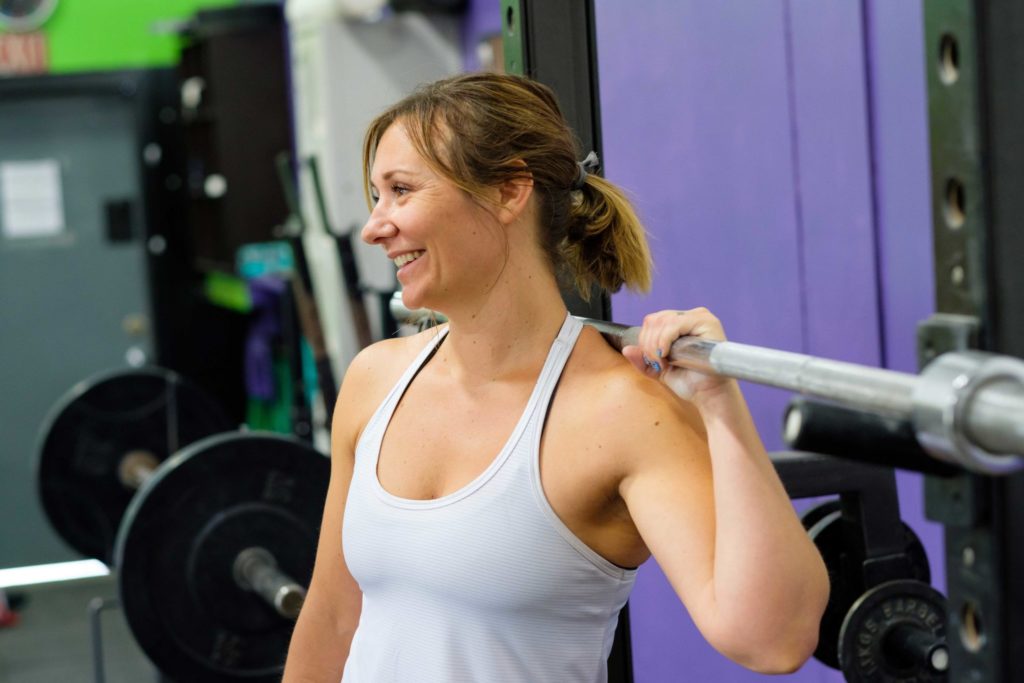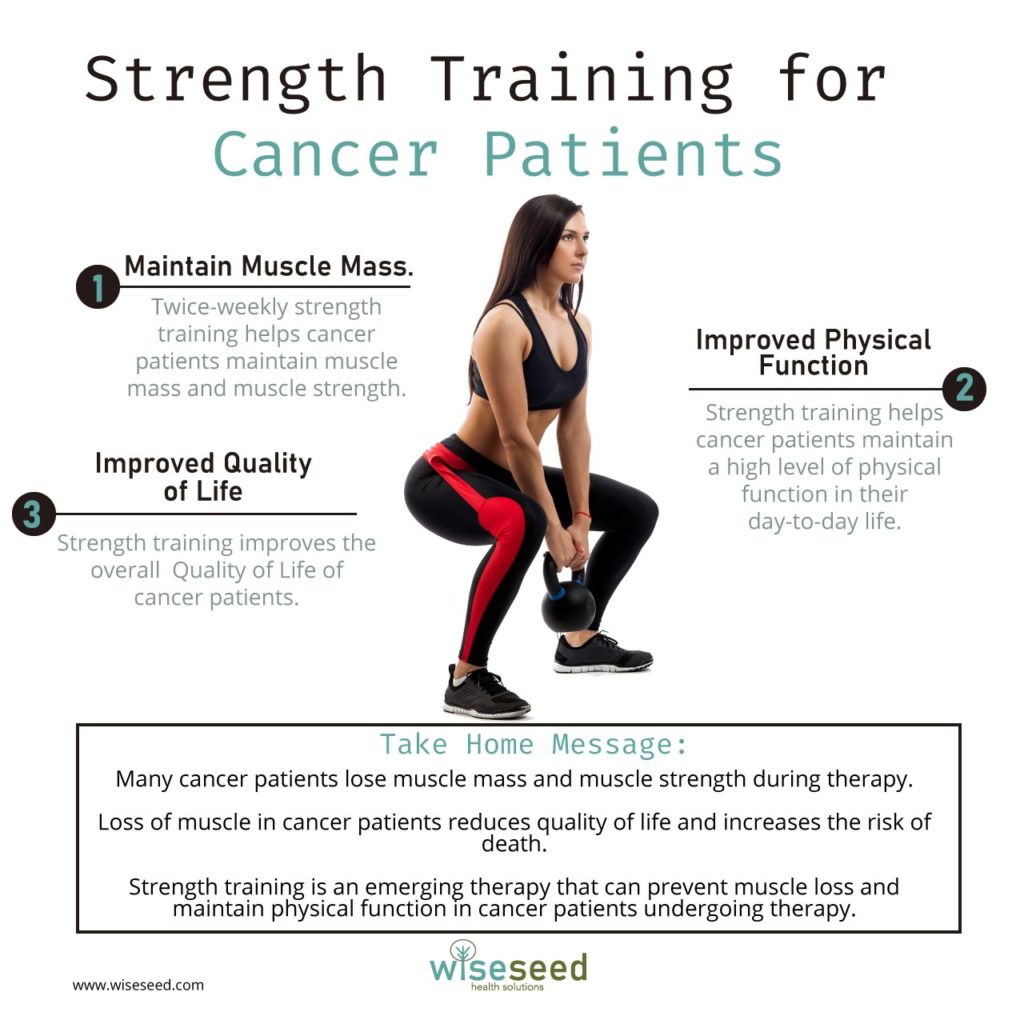Strength Training for Cancer Patients

Muscle Loss and Cancer Survival
One of the common side effects of cancer is the progressive loss of muscle strength and muscle mass 1. This is bad news, as muscle loss in cancer patients predicts worse overall survival 2.
The effect of muscle loss is best understood within breast cancer patients. Unfortunately, over one third of breast cancer patients lose significant amounts of muscle strength and mass during therapy 3. This loss of muscle interferes with everyday activities such as walking, stair climbing, and greatly reduces the quality of life of breast cancer patients.
Worse, when analysing the data from over five thousand breast cancer patients, Zhang and Colleagues found that muscle loss was a strong predictor of mortality 4.
High Intensity Strength Training for Breast Cancer Patients
It is well known that strength training improves muscle strength, size, and function in healthy adults. In particular, programs that involve lifting weights greater than 85% of your one repetition maximum induce large strength gains healthy adults. But can such high training intensities be tolerated by cancer patients?
To find out, Wang and Colleagues took a cohort of newly diagnosed breast cancer patients and got them to perform 4 sets of 4 repetitions of leg press, using 90% of their one-repetition maximum (1RM). They performed this workout twice a week for 12 weeks.
Encouragingly, these patients not only maintained their muscle mass, they also improved their walking economy, and increased their performance across a battery of physical tests that measured both strength and endurance 5. In addition, they also experienced reduced levels of cancer-related fatigue and enjoyed significant improvements in their overall quality of life 6.
Strength Training is Broadly Effective for Breast Cancer Patients
Can such high intensity strength training be scaled to the breast cancer population at large? Two recent large-scale studies suggest that the answer is yes.
The first study analysed the data from five independent clinical trials 7. The Authors found that breast cancer patients who engaged in weekly strength training experienced a 25% increase in strength, with a weekly strength increase of around 3% 7.
The second study analysed the combined the data from 16 independent clinical trials 8. Overall, they found that strength training endowed significant improvement in muscle strength of breast cancer patients 8.
Furthermore, they discovered that strength-trained breast cancer patients experienced an improved quality of life, a reduction in fatigue, less pain during therapy, improvements in self-perception and a reduction in anxiety 8.
Frequency and Intensity

How should breast cancer patients structure their strength training to maximise their health benefits?
Large-scale analysis indicates that strength training performed at at or above 75% 1RM is the sweet-spot for improving strength and physical performance in breast cancer patients 8.
However, the volume of resistance training was found to be inversely associated with increases in muscle strength 8. Therefore, low frequency resistance training, ideally limited to two sessions per week, is optimal for breast cancer patients undergoing therapy. Indeed, a recent clinical trial showed that strength training performed just once a week for eight weeks significantly improved both upper and lower body strength in breast cancer patients 9.
Thus, for breast cancer patients a high intensity, low frequency approach to strength training is the way to go.
Safety
Is intensive strength training safe for cancer patients? Thankfully, the answer is yes.
In 16 clinical trials, strength training did not cause any adverse events during or after therapy, nor was there an increase in the number of fractures or falls resulting from strength training 8. Importantly, strength training reduced the severity and number of symptoms after therapy in breast cancer patients 8.
This suggests that, when appropriately programmed and monitored, strength training is safe for the majority of breast cancer patients.
However, this doesn’t mean that cancer patients should immediately rush to the gym, load up the bar and start smashing out sets of near-maximal squats!
For some cancer patients, strength training is not a safe option. For all of the clinical trials discussed in this article, each-and-every patient was carefully screened by expert clinicians to ensure that they could safely lift weights. Critically, any at-risk patients were prevented from participating in the clinical trials for reasons of safety.
For this reason, if you are a cancer patient, you MUST consult with your oncologist and physician before beginning any exercise or dietary intervention.
Other Cancer Types
Patients with other types of cancer also benefit from strength training. For example, strength training improved the strength, body composition and functional performance of prostate cancer patients 10. Further, in lung cancer patients, exercise interventions have been shown to improve both exercise capacity and muscle force 11.
The Take Home Message
Strength training provides many therapeutic benefits for cancer patients. These include preventing muscle loss, improving physical function, decreasing cancer-related fatigue, reducing pain, alleviating anxiety, and improving body image.
As a result, there are now many clinical trials underway that are optimizing exercise regimes specifically for cancer patients. It is our hope that exercise therapy will soon become an integral part of standard oncology care.
Please click on the link below to download the PDF of the article.

References and Further Reading
1 Cruz-Jentoft, A. J. et al. Sarcopenia: revised European consensus on definition and diagnosis. Age Ageing 48, 16-31, doi:10.1093/ageing/afy169 (2019).
2 Shachar, S. S., Williams, G. R., Muss, H. B. & Nishijima, T. F. Prognostic value of sarcopenia in adults with solid tumours: A meta-analysis and systematic review. European journal of cancer (1990) 57, 58-67, doi:10.1016/j.ejca.2015.12.030 (2016).
3 Caan, B. J. et al. Association of Muscle and Adiposity Measured by Computed Tomography With Survival in Patients With Nonmetastatic Breast Cancer. JAMA Oncol 4, 798-804, doi:10.1001/jamaoncol.2018.0137 (2018).
4 Zhang, X. M. et al. Sarcopenia as a predictor of mortality in women with breast cancer: a meta-analysis and systematic review. BMC Cancer 20, 172, doi:10.1186/s12885-020-6645-6 (2020).
5 Cešeiko, R. et al. Heavy Resistance Training in Breast Cancer Patients Undergoing Adjuvant Therapy. Med Sci Sports Exerc 52, 1239-1247, doi:10.1249/mss.0000000000002260 (2020).
6 Cešeiko, R. et al. The impact of maximal strength training on quality of life among women with breast cancer undergoing treatment. Exp Oncol 41, 166-172, doi:10.32471/exp-oncology.2312-8852.vol-41-no-2.13249 (2019).
7 Lopez, P. et al. Resistance training in breast cancer patients undergoing primary treatment: a systematic review and meta-regression of exercise dosage. Breast Cancer, doi:10.1007/s12282-020-01147-3 (2020).
8 Montaño-Rojas, L. S., Romero-Pérez, E. M., Medina-Pérez, C., Reguera-García, M. M. & de Paz, J. A. Resistance Training in Breast Cancer Survivors: A Systematic Review of Exercise Programs. Int J Environ Res Public Health 17, doi:10.3390/ijerph17186511 (2020).
9 Santos, W. et al. Once a Week Resistance Training Improves Muscular Strength in Breast Cancer Survivors: A Randomized Controlled Trial. Integr Cancer Ther 18, 1534735419879748, doi:10.1177/1534735419879748 (2019).
10 Keilani, M. et al. Effects of resistance exercise in prostate cancer patients: a meta-analysis. Support Care Cancer 25, 2953-2968, doi:10.1007/s00520-017-3771-z (2017).
11 Cavalheri, V. et al. Exercise training undertaken by people within 12 months of lung resection for non-small cell lung cancer. Cochrane Database Syst Rev 6, Cd009955, doi:10.1002/14651858.CD009955.pub3 (2019).

Ten Minutes is All You Need
Research has shown that ten minutes of moderate-to-vigorous exercise performed each day is enough to significantly reduce your risk of early death.

How to Sprint Safely
Healthy adults can sprint safely if they build a strong aerobic and strength base, strengthen their hamstring and calf muscles, and apply a sub-maximal approach to sprint training.




